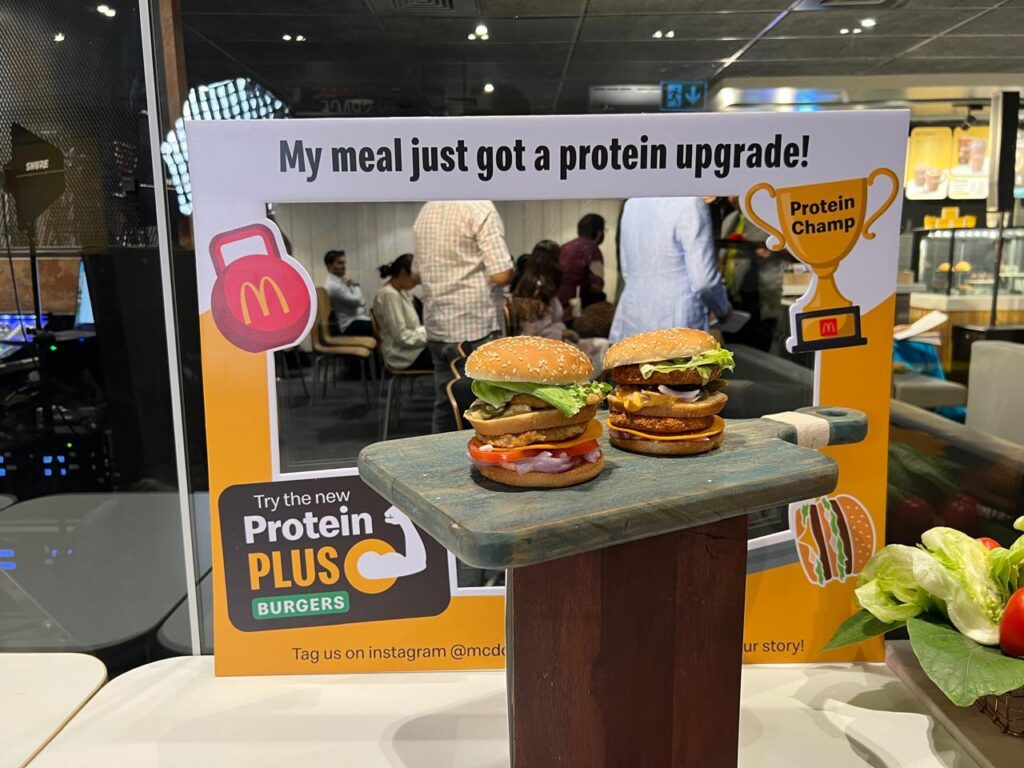
McDonald’s is targeting India’s protein craze with a meat-free Protein Plus range to boost the nutritional content of its burgers.
The latest company to hop on India’s protein train is the world’s largest food corporation.
McDonald’s India, already home to one of the chain’s most extensive meat-free menus globally, has launched a Protein Plus range to power up its existing burgers with vegetarian protein slices.
While the slices aren’t vegan-friendly – they’re made from a mix of soy, pea and whey protein – their rollout comes amid rising demand for plant proteins in India. This year, 37% of its citizens are looking to add more of these to their diets.
The circular slices can be added to any burger, each adding five grams of protein. They’re a result of McDonald’s ongoing collaboration with the CSIR-Central Food Technological Research Institute (CFTRI), part of the national science and technology ministry.
“We believe in giving our customers choices, and this time, we are giving them the power to personalise their protein intake,” said Akshay Jatia, CEO of Westlife Foodworld, which operates McDonald’s stores in West and South India. “The Protein Plus range allows them to enjoy their favourite McDonald’s burgers without compromising on their protein needs or taste.”
Protein Plus looks to tackle India’s deficiency

Swathes of studies suggest that India has a protein problem. According to one survey, 73% of the country has a deficiency. That said, a separate analysis of household food intakes reveals that the risk of protein deficiency, when adjusted for digestible quality, is low in adults and non-existent in young Indians.
But the protein trend isn’t going anywhere. And in a country with the world’s largest vegetarian population, the appetite for meat may be shrinking. Research shows that more Indians want to increase their intake of vegan meat alternatives (43%) than conventional meat (36%), while two in five want to cut back on the latter.
It’s why McDonald’s is going big on meat-free. The Protein Plus slices are part of its Real Food, Real Good philosophy, a quality-focused initiative that ensures menu items are free from artificial colours, flavours, and preservatives.
The slices contain gluten and refined soybean oil, and carry a cheesy base flavour and buttery top note. They can be found across all McDonald’s stores in West and South India, and are available in Protein Plus Meals (the vegetarian version pairs a protein-enriched veggie burger with a protein-rich corn cup and Coke Zero).
Customers can add multiple Protein Plus slices to their burgers, with each setting them back ₹25 ($0.29). Among its vegetarian options, a Veg Maharaja Mac with one protein slice will contain 29g of protein, while a double patty of the McSpicy Paneer burger will pack around 45g of protein. The new innovation is so popular, it sold out on day one.
The slices are the second product to come out of McDonald’s India’s collaboration with CFTRI, following the launch of the Multi-Millet Bun. “We are grateful to CSIR-CFTRI for partnering with us to bring this forward-thinking product to life,” said Jatia.
“Together, we remain committed to crafting menu items that are wholesome and delicious, combining locally available ingredients in a way where great taste and nutrition go hand in hand.”
Can McDonald’s lead India’s meat-free protein space?

Sridevi Annapurna Singh, director of CFTRI, said: “The Protein Plus slice is an outcome of science-backed formulation and a shared vision to elevate everyday meals through nutrition. This partnership showcases how the food industry and scientific institutions can come together to bring meaningful nutritional upgrades to mainstream eating.”
The new range was unveiled at an event in Mumbai last week, which was attended by Yogesh Kadam, the minister for the state’s Food and Drug Administration. He noted that the initiative reflected the Food Safety and Standards Authority of India’s Eat Right India movement, which aims to promote safe, nutritious and sustainable food choices.
“It is heartening to see scientific research institutions and industry leaders come together to contribute towards national nutrition goals,” he said. This partnership model is vital for strengthening our public health landscape.”
The move comes just as India’s foodservice industry amps up its protein focus. Such is the demand that Swiggy, one of India’s two major food delivery platforms, launched a dedicated High Protein category on its app this month.
“As consumers become aware of the importance of protein in their diets, we know that they would not immediately shift away from their favourite items,” said Sidharth Bhakoo, chief business officer at Swiggy Food Marketplace. “The launch of this new [Protein Plus] range is a step forward in upping the protein consumption of consumers, while also enabling them to enjoy their favourite burger.”
Last year, a report by the Good Food Institute (GFI) India suggested that there’s a “lack of consumer demand” for meat analogues at restaurants, prompting the call for better education and menu integration.
“The real barrier is not the lack of awareness but the need for a mindset change,” noted Pranav Rungta, vice-president of the National Restaurant Association of India. “With the foodservice industry growing and becoming more organised, educated restaurateurs who understand the impact of health, nutrition, and alternative proteins are also growing.”
Within McDonald’s, the fortunes of plant proteins are topsy-turvy. The company has seen strong sales of the Beyond Meat-containing McPlant in most parts of Europe, though the vegan burger failed to take off in the US. Now, it has reportedly removed it from its Austrian menu too, opting to run out its contract with the plant-based meat maker instead of renewing it.
In Canada, the McPlant did not find much success either. McDonald’s chose instead to focus on vegetable-led offerings in that market, trialling a McVeggie burger at dozens of locations earlier this year.
The post McDonald’s India Unveils with Vegetarian ‘Protein Plus’ Slices to Meet Skyrocketing Demand appeared first on Green Queen.
This post was originally published on Green Queen.